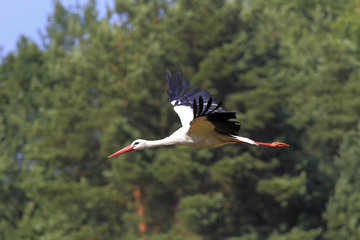'We can't simply lock up animals in protected areas'
Interview with Martin Wikelski about how humans continue to restrict the range of motion of animals.
With its annual report "Environment Frontiers", the United Nations Environment Programme (UNEP) outlines the challenges that will have a decisive influence on the natural foundations of life on our planet in the future. In their report 2018/2019, the authors call "Ecological Networking: Bridges to Greater Biodiversity" one of the great challenges of the future.

Today, most protected areas lie like islands in an ocean of human-made landscapes. Intensively used agricultural landscapes and settlements act as insurmountable barriers for many animals and plants, preventing any exchange between the protected areas. Martin Wikelski from the Max Planck Institute for Ornithology in Radolfzell has learned from his research that many animals travel long distances.
Why is it not enough for species protection to simply designate enough nature reserves and national parks?
Almost all animals around - some more, others less. Through our research, we know that many more animals are migrating than we thought for a long time. Young animals in particular often have to leave their parents' territory and move away.
We will not be able to ensure the survival of such species if we place them in protected areas.
That is why we must think about dynamic protected areas. If a site is an important base for a species at a particular time of year, for example, it should be protected for a limited period of time. The rest of the year it could then be used again by humans.
Why do protected areas have to be interconnected?
Today, many animals and plants live in populations that are isolated from each other, which means that they can no longer exchange information with each other. By exchange I mean genes, to ensure that the populations do not become genetically impoverished, but also culture, because animals also pass on knowledge to one another. If, for example, different stork populations no longer come together, they can no longer pass on their knowledge about different flight routes to wintering areas
Is there a sufficient degree of public awareness about this topic?
Far too little - ecological networking is still a marginal topic for specialists. We lock up wild animals in protected areas and believe everything is fine. In the Anthropocene, we need a completely new relationship between humans and animals: the relationship must become closer.

However, we still know too little about the needs of the various species. With our Icarus project, we can accompany animals on their travels. They can more or less ‘tell’ us what they need. We can then use this knowledge to protect the right habitats.
What measures can be taken to link habitats?
Protected areas can be connected by corridors, roads by wild bridges. Often, however, no elaborate measures are required. Much would already be gained, for example, if we were to preserve a structurally rich landscape through which animals could migrate, or if we were to make our garden fences permeable for animals.
What is the current situation regarding the networking of protected areas in Germany?
The 'Green Belt' is also an outstanding example even on an international scale. Large sections of the former domestic German border were placed under protection after the fall of the Berlin Wall Today, these areas are very valuable habitats and offer many animals and plants the opportunity to spread.
Here in Baden-Württemberg, there is a technical plan "State-wide Biotope Network". It is intended to restore ecological interrelations in the landscape and enable the spread of animals and plants. Lynxes from the Eifel region migrate along these corridors to the Black Forest. For example, we are currently looking for a lynx that has been equipped with a signal transmitter in the Eifel and has now moved to the Black Forest.













